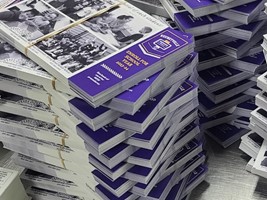From traditional layouts with landscape orientation to trendy textured stock, business cards are as unique as your company. But, ensuring that every element of your professional business cards is high-quality, current, and memorable is essential.
While these small cards might seem simple at first glance, their design and content require careful consideration to communicate your professional identity and brand effectively.
Whether crafting your first card or looking to refine an existing design, these guidelines will help you create a memorable business card that will be a powerful tool in your networking arsenal.
Let's dive into the details that can make or break the effectiveness of your business card.
6 Dos of Business Card Design
1. Do: Keep it Simple
Your business card should convey the most essential information about you and your company without overcrowding.
Include your name, job title, company, phone number, and email address. A clean layout with plenty of white space enhances readability and presents a professional image.
2. Do: Choose the Right Font
Select a font that is professional and easy to read.
Classic fonts such as Helvetica, Arial, or Times New Roman can be excellent choices. The font size should ensure that all text is legible, typically around 8 to 11 points.
3. Do: Use Texture
People don't just remember what your business card looks like; they remember how it feels.
Maybe it's got a special touch, like raised embossing, that sets it apart and makes it stick in their minds. You can also use a matte or gloss finish to give your cards a bit of shine or a more subdued, flat look, depending on the impression you want to leave.
And don't forget about textured stock! It's a surefire way to make your card stand out from the usual flat paper ones, adding a unique feel that folks won't forget in a hurry.
4. Do: Incorporate Your Brand
Your business card should reflect your company’s branding.
Branding elements typically include your logo, color scheme, and overall design aesthetics. Consistency with your other branded materials reinforces your business identity and helps make your card memorable.
5. Do: Use High-Quality Materials
The material of your business card contributes to the impression you leave.
Using heavier paper or unique materials (like metal or plastic) can make your card stand out and be remembered.
6. Do: Add a Creative Touch
If it fits your industry, adding a creative element to your card can make it stand out.
Some creative ideas to consider are an unusual cut, rounded corners, or interactive elements like a QR code.
6 Don’ts of Business Card Design
1. Don't: Include Spelling Errors
One simple mistake can steal away a potential client.
Typos can accidentally redirect potential customers away from your website and onto someone else’s, call another company, or lead clients to the wrong physical address.
Trust our skillful printing experts with quality control of your paramount professional business cards.
2. Don't: Allow Clutter to Creep In
A cluttered business card is challenging to read and can be off-putting.
Don’t complicate the font or graphics on a business card, which naturally has minimal surface space. Resist the urge to fill every space. Including multiple contact methods or excessive details can overwhelm the recipient and detract from the primary information.
3. Don't: Be Caught Without Your Cards
Always have your business cards on hand.
You never know when a networking opportunity might arise, and being unprepared can mean missing out on a potential connection.
Our local print experts can ensure you have the volume of quality business cards you’ll need to pass out so you come prepared for your next conference, meeting, and beyond.
4. Don't: Get Too Personal
While it’s nice to show personality, sharing too much personal information or using overly casual design elements can seem unprofessional.
Keep the design aligned with your industry standards and professional image.
5. Don't: Appear Unprofessional
Creativity should not compromise the professional quality of your card.
Ensure that any creative elements do not obstruct the clarity of essential information, like your contact details.
6. Don't: Include Outdated Information
Ensure all the information on the business card is current.
Distributing cards with outdated contact details or old logos can confuse potential contacts and suggest a lack of attention to detail. Update your cards regularly to keep them current.
Contact our printing professionals today to begin crafting your updated and elevated business cards!




